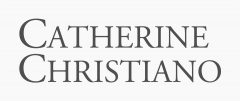ABOUT FINE ART REPRODUCTIONS
This website features a fine selection of limited edition archival pigment reproductions (also known as giclées) of Catherine Christiano's original art works. In the world of fine art the terms giclée, digital print, archival pigment print, and high resolution inkjet print are used interchangeably and refer to the same printing process that is at the leading edge of digital printing technology. Giclée printing, first introduced in the early 1990s and once known as Iris printing, has evolved to now include the use of archival pigment inks and heavy weight archival papers (including watercolor, textured, and smooth fine art papers and canvas) that increase the longevity and durability of the image.
The professional inkjet printers that create giclées are similar to household inkjet printers in that they produce an image by releasing minute droplets of ink through multi-nozzle print heads onto paper. Professional injet printers differ in that their print heads are designed to hold more colors than the basic CMYK configuration and hold archival pigment inks in lieu of the less expensive, more ephemeral dye based inks. It is a continuous tone process, meaning there is no dot pattern. This results in incredible detail with matchless color density, saturation, and brilliance. When high quality fine art archival papers are employed, the results are impressive and the image stability is superior to that of any other method of printing. For the archival pigment inks used by the studio Epson reports that the image will remain light resistant from approximately 61 to 76 years.(i)
Archival pigment prints can now be found throughout the fine arts establishment including in the collections of major museums, like the Metropolitan Museum of Art and the Museum of Modern Art, and at highly reputable galleries. Other artists who have created giclées include Chuck Close, David Hockney, Damien Hirst, Andrew and Jamie Wyeth, and Richard Avedon.
Imagine going through life without recorded music, with the only possiblity of hearing a favorite performer being live performance? Like music recordings, reproductions enable many people to invite art into their homes and workspaces. Catherine Christiano's original works are high in value and are often located in private collections, so the studio is pleased to be able to offer this affordable and very high quality option for many people to enjoy Catherine Christiano's art.
(i) Keep in mind that this is by no means a guarantee and that all works of art will change with environmental conditions, especially with light exposure. Please refer to the information provided through the link Framing And Caring For Your Fine Art Print or Reproduction.
WHAT'S THE DIFFERENCE BETWEEN A FINE ART PRINT AND A REPRODUCTION?
Although these two words seem synonymous the difference between them is important, especially to collectors. A print is an original work of art, whereas a reproduction is a printed copy of an original work of art. Original fine art prints are created with the direct involvement of the artist. If the master image is created by the artist using a stone or plate, the printing may be done either by the artist or by someone under the artist's supervision. The master image may also be created digitally, where the artist begins with digital photography or scans, manipulates the image using software like Photoshop, and electronically prints the image. On the other hand, reproductions are created by taking a very high resolution photograph or scan of an original work of art and printing the image electronically. The best quality prints and reproductions are approved and signed by the artist. In general, a print will be of higher value than a similarly sized reproduction by the same artist.
